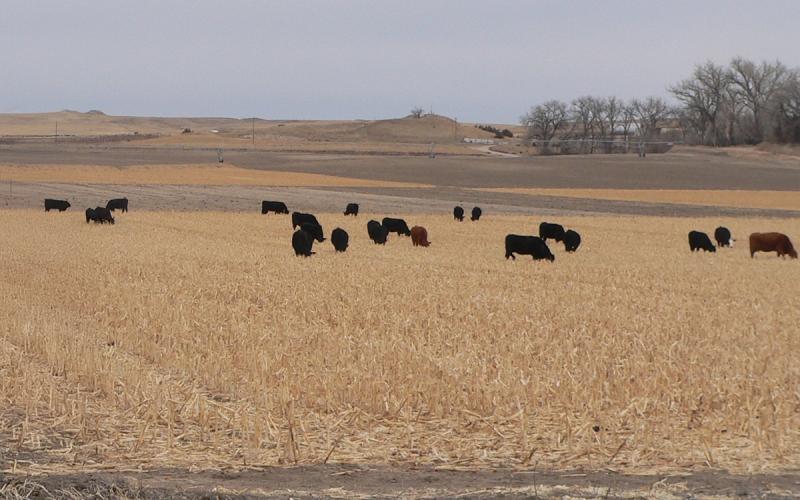As wheat harvest is underway it is important to ensure that grain bins are prepared in the best possible manner to prevent insect infestations. The general rule of thumb is the longer grain is stored, the greater the chance of an infestation occurring. There are seven steps that can be taken to help reduce the chances of having infested grain. Under most storage circumstances, it is not necessary to treat grain with a protectant insecticide prior to binning (See Table 2 for information on protectant insecticides). This is true for grain that will be removed from storage by May or June of the following spring, or that will be used on-site as livestock feed within one year of harvest. However, a protectant insecticide should be applied to grain that is expected to be stored for more than one year. If a protectant insecticide application is necessary, it should only occur after the grain has reached the optimal storage moisture. These insecticides can be applied at the auger while the bin is being filled, or as a surface treatment that is referred to as either top-dressing or capping-off.
Bin Inspection
Stored grain with a temperature above 55-60°F should be inspected each week, and every two weeks when the temperature is below 55°F. When inspecting stored grain, it is important to remember the potential associated hazards. For instance, suffocation can occur in grain bins due to bridged grain; bridged grain occurs when grain mats together and forms a false floor. When the false floor is broken during sampling procedures, cave-ins can occur. Where possible:
- Always have another person with a cell-phone outside the bin in case there is a problem.
- Wear a harness that is attached to a properly secured rope when entering a grain bin.
- Use a pole to break up crusted grain from a distance.
Stored Grain Integrated Pest Mangagement: 7 Steps
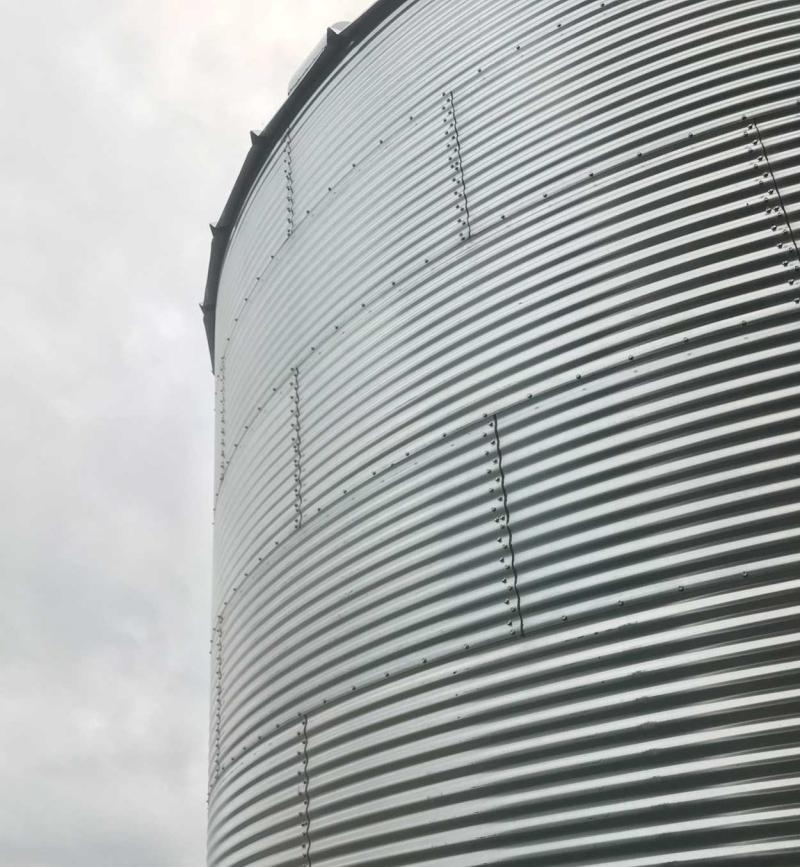
The seven components to a stored grain integrated pest management (IPM) plan are as follows:
Step 1. Structural and Maintenance Components: keep bins clean and repaired.
All season:
- Keep a 10 ft. perimeter around the bin free of vegetation and trash.
- Clean up grain spills outside of the bin.
Pre-binning:
- Bins built on moisture-proof base
- Confirm that bin facilities are weather tight and rodent proof.
- Screen ventilation openings to prevent entry of rodents and birds.
- Do not mix new and old grain; remove all old grain from bin or fumigate old grain.
- Clean the bin wall, ceiling, ledges, floors, and sills prior to filling with new grain.
- Clean combine, wagons, grain carts, and trailers prior to handling new grain.
- Dispose of any debris removed from bins or machinery as insects may infest it.
- Examine area to determine if rodent bait stations are necessary.
Post-binning:
- Seal any holes, and caulk around any doors.
- Do not seal roof aeration exhaust of inlet vents except during fumigation.
Step 2. Residual insecticide sprays (Table 2).
Pre-binning:
- Spray the wall surfaces, ledges, floors, and sills with a residual insecticide.
- Spray outside walls and outside base.
- For long-term storage (> 1 year) consider fumigating the area beneath the slotted floor. (Table 2 for information regarding insecticides).
Step 3. Condition grain: store clean, dry grain.
Pre-binning:
- For long term storage corn moisture should be 13-14%, soybean at 11%, wheat at 13.5%, and oil sunflowers at 8% or less.
- Use a grain cleaner to remove cracked kernels and other debris.
Step 4. Proper aeration.
Post-binning:
- Run bin fan and stirator to ensure uniform temperatures and prevent moisture buildups. This will reduce mold growth.
5. Use insecticide protectants (Table 2).
- Treat grain as it is moved into storage.
6. Regularly inspect grain.
Post-binning:
- Monitor the grain regularly. For grain above 55-60°F inspect weekly. For grain below 55°F inspect every two weeks.
- Use a grain probe to take samples in a pattern from the surface, and also from the base of the grain mass.
- Take samples from the center to the areas near the wall, with samples being no further than 20 feet apart.
- “Hot spots” felt on the grain surface or unusual odors are indicators of insect activity and should be examined.
- During the winter, insects will move to the center of the bin, so sampling at that location is important.
7. Treating detected infestations when necessary.
Post-binning:
- If an insect infestation is detected:
- Move the grain and re-treat as in Step 5. It is possible to kill some of the insects if the grain is moved during cold weather.
- Feed the grain to livestock.
- Sell at a reduced price.
- Fumigate (Table 1).
Note: All precautionary maintenance steps should be taken two weeks prior to binning.
Insecticide Applications
If an insect infestation is detected in stored grain, the grain can either be moved and have a protectant insecticide applied, fed to livestock as-is, be sold at a reduced market value, or be fumigated (Table 1). Due to the hazardous nature of fumigant insecticides we strongly recommend that the application of these is done by a hired professional. Many of these products are activated by moisture, including the moisture present in air. This means the second the seal is removed, or the package is opened, the product is active. The application of fumigants should be done with a forced air or oxygen provided respirator system to prevent any negative health impacts including death. Always read and follow the label directions when using any pesticide product. Applicators using fumigants must also prepare and follow a fumigant management plan.
| Active Ingredient | Insecticide* | Re-entry Interval (REI) | Comments |
|---|---|---|---|
| Aluminum phosphide |
|
|
|
| Carbon dioxide (CO2) |
|
|
|
| Magnesium phosphide |
|
|
|
| Methyl bromide |
|
|
|
- All fumigant insecticides are restricted use products and cannot be purchased or applied without proper certification and licensing. Follow all label instructions.
- Parts per million (PPM)
Note: This list is not meant to be comprehensive. Mention of a trade name neither constitutes endorsement of the products mentioned nor criticism of similar ones not used or mentioned.
| Active Ingredient | Insecticide* | Re-entry Interval (REI) | Comments |
|---|---|---|---|
| Bacillus thuringiensis kurstaki |
|
|
|
| Beta-cyfluthrin |
|
|
|
| Deltamethrin |
|
|
|
| Dichlorvos resin strips (DDVP) |
|
|
|
| pirimiphos-methyl |
|
|
|
| Pyrethrin |
|
|
|
| (S)-methoprene |
|
|
|
| Silicon dioxide (diatomaceous earth) |
|
|
|
| Malathion |
|
|
|
- Follow the label instructions for all pesticides. Always wear proper personal protective equipment.
Note: This list is not meant to be comprehensive. Mention of a trade name neither constitutes endorsement of the products mentioned nor criticism of similar ones not used or mentioned.
Bin Aeration
Stored grain insect pest development begins to slow when grain temperatures drop to around 60°F, and essentially stop when the temperature drops below 55°F. Because of this it is important to lower grain temperatures and reduce the risks of stored grain pests. Stored grain can be cooled once the outdoor temperatures begin to drop in the fall. For bins that are equipped with fans, run the fan during these cooler temperature periods to cool the grain. In addition to reducing potential insect issues, proper aeration of the grain will help maintain uniform temperatures throughout the bin. This will eliminate “hot pockets” that are favored by insects and mold. To ensure optimal airflow, level off the grain once the bin has been filled. When the grain is not level, areas with peaks can provide optimal conditions for stored grain insect outbreaks.
Common Stored Grain Insect Pests
There are several species of insects that feed on stored grain. Both the immature (larval) and adult stages of stored grain beetles are capable of causing damage to grain, while only the larval stage of the stored grain moths cause damage. These insect pests can be grouped based on whether they are internal feeders or external feeders. Internal feeders feed within the kernels while external feeders will consume grain dusts, cracked kernels, and other grain debris. Below are the common internal and external stored grain pests. In addition to these, other species including the foreign grain beetle and hairy fungus beetle may be observed in a bin. These beetles are feeding on the molds or fungi growing on the grain.
Internal Feeders
Weevils
Of the internal feeders, weevils (Figure 1, Figure 2, and Figure 3) are generally given the most attention because they are among the most destructive pests of stored grain. The larvae of grain weevils develop within the kernels, and when infested grain is left undisturbed for long periods of time can cause nearly complete destruction. Adult weevils are easily distinguished from other beetles by their elongated snouts.

Granary Weevil (Sitophilus granarius)
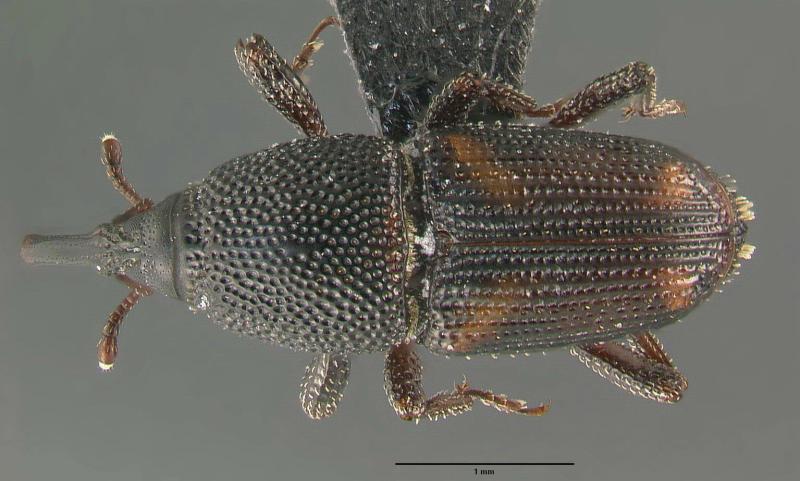
Maize Weevil (Sitophilus zeamais)
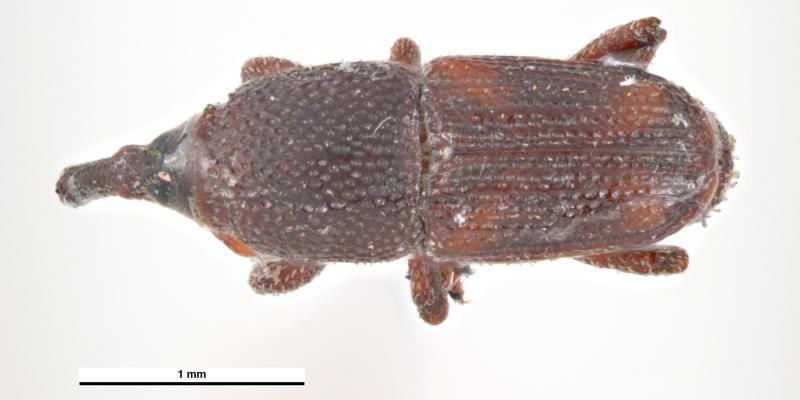
Rice Weevil (Sitophilus oryzae)
Lesser Grain Borer
The lesser grain borer (Figure 4) is a pest of a wide variety of grains. The larvae and adult of this pest are damaging. The larvae of this pest are unable to infest undamaged kernels. In addition to kernels, the larvae are also able to develop on grain meal.

Lesser Grain Borer (Rhyzopertha dominica)
Angoumois Grain Moth
The larvae of the angoumois grain moth (Figure 5, adult moth) are typically not a pest of shelled grain. However, the larvae are a pest of ear corn and can infest the corn before it is harvested. The larvae feed inside kernels and cause an unpleasant smell. During warm falls, several generations of the moth can be completed resulting in significant damage.
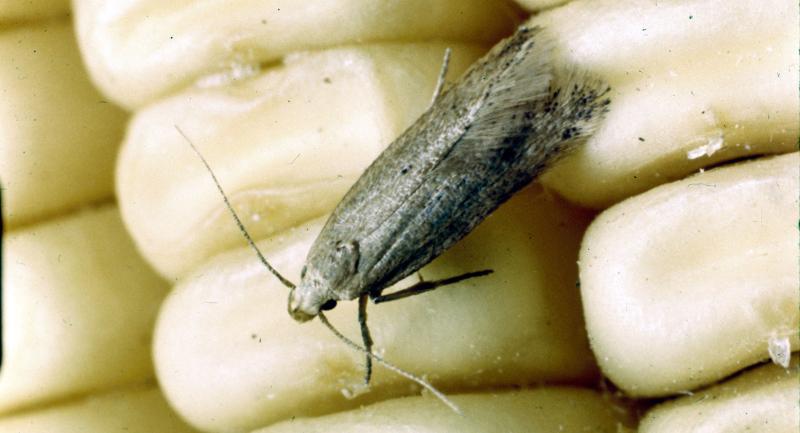
Angoumois Grain Moth (Sitotroga cerealella)
External feeders
The stored grain pests that are external feeders are present in the grain because grain dusts, cracked kernels, or other grain debris are present and are a viable food source. Similar to internal feeders, the best management for these insects is prevention. The presence of fungus feeders indicates that the grain is moldy. Proper aeration and grain cleaning can prevent most infestations caused by external feeders.
Beetles
The cadelle beetle (Figure 6), confused flour beetle (Figure 7), flat grain beetle (Figure 8), red flour beetle (Figure 9), and sawtoothed grain beetle (Figure 10) are present in the grain due to the availability of cracked kernels, dust, and other grain debris. In some instances, these beetles will feed on kernels that were damaged by internal feeders.
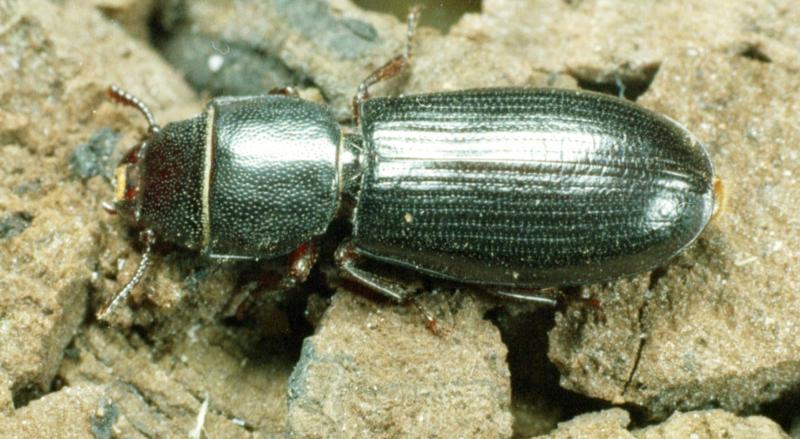
Cadelle Beetle (Tenebroides mauritanicus)
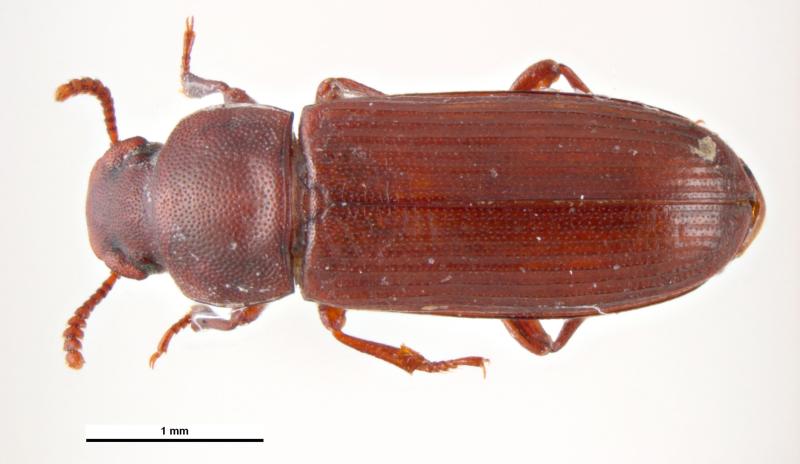
Confused Flour Beetle (Tribolium confusum)
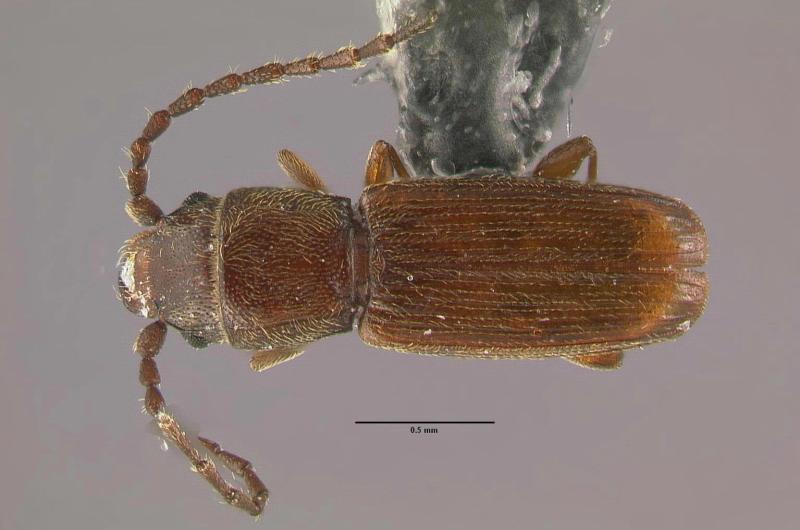
Flat Grain Beetle (Cryptolestes pusillus)

Red Flour Beetle (Tribolium castaneum)

Sawtoothed Grain Beetle (Oryzaephilus surinamensis)
Indian Meal Moth
The larvae of the Indian meal moth (Figure 11, adult moth) cause direct damage to the grain by feeding on the seed germ. The larvae of this pest also reduce the quality of grain by producing waste and constructing silken webs in the grain. These webs are often observed on the top surface of the grain and can become quite thick.
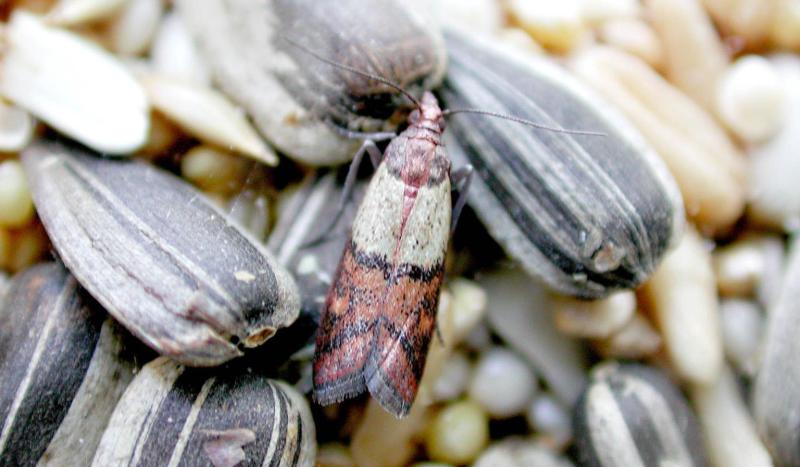
Indian Meal Moth (Plodia interpunctella)


